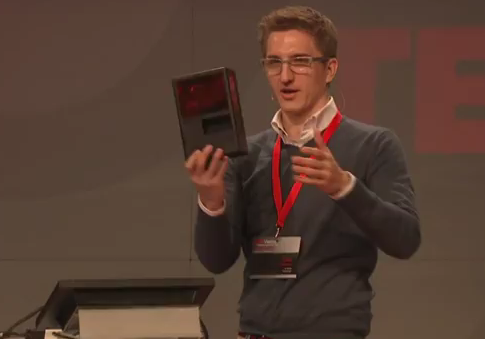The World’s Smallest 3D Printer
Ever dreamt of making something from your computer come to life? How about going beyond the rules of the virtual realm and taking what you see on the screen into your hands? If these supposedly impossible ideas have swirled inside your mind at least once, the 3D micro printer might just be the thing for you.
At first, it probably sounds crazy: “How could the 3D micro printer do all of this?” To cut the long story short, it makes your virtual fantasies come to life by taking an image from your computer and printing out a 3D model of the said image. Of course, that’s only half the story behind this nifty device. The 3D micro printer is a breakthrough the present generation must learn more about, because it promises a future of possibilities and—to our personal liking—convenience.
You can learn more about 3D printers by reading this Wildcard article.

Klaus Stadlmann presents the 3D micro printer during his talk at the TEDxVienna conference.
From 3Ders
Basically, what it does is take a picture from your device and mold it out layer by layer on the printing platform. The whole process is as simple as it is mentioned in the said article. But let’s not get confused here. As you might have read, 3D printers are different from 3D micro printers, though they have roughly the same functions. What probably makes these two different is portability. Both printers work under the same procedures mentioned earlier, but the lighter and smaller micro printer is easier to use. Though the micro printer certainly has that handy trait, there’s also the matter of printing out models smaller than the desired size. On the other hand, the 3D printer is designed to print out models bigger than what the micro printer can provide, presenting a wider array of printable models. Rest assured, though, because the precision in detail is one thing these printers won’t betray.
To make it clearer, try visualizing the hat of a magician. Think of yourself delving your hand right into it, quietly wishing that whatever comes out isn’t breathing. You stick your hand in, pull that object up slowly—whatever it might be—and examine what you just hauled out. Though it has an actual image of the object it has to print out from the beginning, the 3D micro printer does the same by literally pulling the model out from a platform containing the liquid as the device shapes the model slice by slice.
It also works as if you’re blowing out a bubble, except that it’s composed of layers upon layers of images, just like an onion’s body. To paint a clearer picture of this process, think of printing out a 3D model using an average printer. To do that, you would have to print out page by page each layer of the 3D representation, cut the excess parts out from the printed pages and paste them on top of each other.
This is a lot of work, especially with the risk of messing things up, and the gruesome possibility of using up a whole bookstore’s worth of paper and ink just for your little experiment.
Here’s a video of the process:
With the 3D micro printer, you can put worries—like making a solar system model for your science project, or getting that action figure you’ve always wanted—to rest. It might render only relatively small, portable figures of 3D images and their sizes might not be as big as the Eiffel Tower (just in case you want your own version of that structure in your backyard), but the details of the figure will turn out as precisely as its original. However, the micro printer is not as small as its name suggests. Still, it’s fairly easier to carry around than your average printer—which undoubtedly weighs a ton—and smaller than your math textbook, which seems to take up all the space in your backpack.
Before we get ahead of ourselves, remember that the 3D micro printer isn’t just for fun and games. Think about what we could do with the very idea of taking something out of the screen and molding it into something real. Take into consideration the ideas that could sprout from it and you’ll know that the micro printer is just the tip of the iceberg. Prosthetic body parts, a means for organ transplant, innovations for stem cell technology—all these things could be made possible if the pursuit for a newer and better version of the 3D micro printer is actively in progress.
Science doesn’t stop at anything. It presents a future we can all hope for and a dream our passionate and unrelenting scientists can guarantee will be granted. The 3D printer is only one of those dreams, and putting all personal fantasies like building your own mini version of the Pyramids of Giza out of the way, this technology inspires a worldwide innovation—a small step for an improving era that we are all a part of.
Sources:
3Ders. 3D Behind the invention of world’s smallest 3D printer: http://www.3ders.org/articles/20111211-behind-the-invention-of-worlds-smallest-3d-printer.html [17 October 2015]
TEDx. The world’s smallest 3D printer: https://www.ted.com/talks/klaus_stadlmann_the_world_s_smallest_3d_printer [17 October 2015]
Gizmodo. The World’s Smallest 3D Printer Costs Less Than $300: http://gizmodo.com/the-worlds-smallest-3d-printer-costs-less-than-300-1653212735 [17 October 2015]
Youtube. This new type of 3D printing was inspired by Terminator 2: https://www.youtube.com/watch?v=l3TgmvV2ElQ. [17 October 2015]

Comments